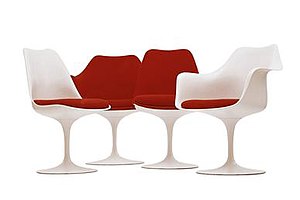Tulip chair
 From Wikipedia the free encyclopedia
From Wikipedia the free encyclopedia
 Colors: White frame. Cushion red (cushion variable) | |
| Designer | Eero Saarinen |
|---|---|
| Date | 1956 |
| Materials | Aluminium base, Fiberglass frame. Leather or fabric cushions |
| Style / tradition | Modernist |
| Height | 80 cm (31 in) |
| Width | 50 cm (20 in) |
| Depth | 56 cm (22 in) |
The Tulip chair was designed by Eero Saarinen in 1955 and 1956[1] for the Knoll company of New York City.[2] The designs were initially entitled the 'Pedestal Group' before Saarinen and Knoll settled on the more organic sounding 'Tulip chair' to mirror its inspiration from nature.[3] It was designed primarily as a chair to match the complementary dining table. The chair has the smooth lines of modernism and was experimental with materials for its time. The chair is considered a classic example of industrial design.
The chair is often considered "Space Age" for its futuristic use of curves and artificial materials.
Design and construction[edit]
Saarinen said: "The undercarriage of chairs and tables in a typical interior makes an ugly, confusing, unrestful world. I wanted to clear up the slum of legs. I wanted to make the chair all one thing again."[4]
Saarinen had hoped to produce the chair as a one piece unit made entirely of fiberglass, but this material was not able to support the base, and prototypes were prone to breakage. As a result, the base of the tulip chair is of cast aluminum with a rilsan-coated finish to match the upper shell, giving the appearance of a single unit. The upper shell is molded fiberglass, with a reinforced, plastic bonded finish.[1] The upholstered foam cushion is removable with Velcro fastening.[2]
Saarinen was awarded a patent for the Tulip chair in 1960.[5]
Awards[edit]
- Museum of Modern Art Award, 1969[2]
- Federal Award for Industrial Design, 1969[2]
- Design Center Stuttgart Award, 1962[2]
Project Cybersyn[edit]
In 1971 a modified form of the Tulip chair was used in the design of Project Cybersyn.[6]
See also[edit]
References[edit]
- ^ a b "Eero Saarinen. Tulip Armchair (model 150): 1955-56". Museum of Modern Art.
- ^ a b c d e "KnollStudio Tulip Chair". knoll.com. Archived from the original on 2010-12-20. Retrieved 2009-11-10.
- ^ "A Tulip Design History". The Little Tulip Shop. Retrieved 2022-06-19.
- ^ Ronan, Alex (January 28, 2015). "Design Dictionary: Tulip Chair". Dwell magazine.
- ^ Tulip chair
- ^ Free As In Beer: Cybernetic Science Fictions accessed April 7, 2012